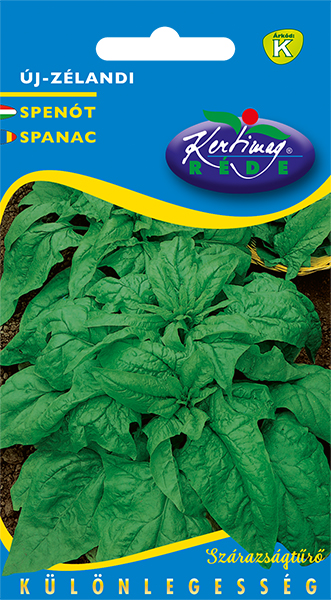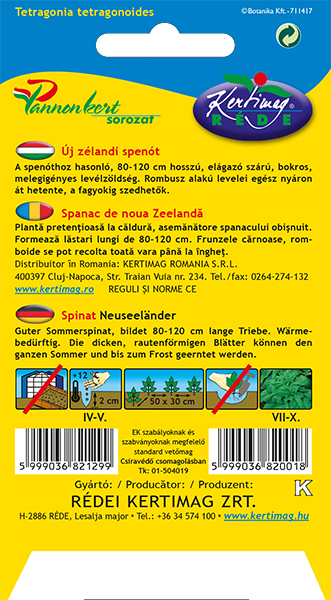Spinach New Zealand 3 g
| HUF 369 * (nettó: HUF 291) | |
Description of New Zealand spinach:
New Zealand spinach is a thick, fleshy-leaved, fleshy-petioled annual herb with soft stems. The leaves are triangular in shape, but deltoid leaves also occur. The leaf edge is intact, sloping back towards the backhand. They have a small number of respiratory openings to reduce evaporation. The elongated, mucilaginous sap of the leaves also helps the plant to retain water. The leaves are scattered. The roots do not store water, yet the plant manages its limited water supply well because of the thickThe thin leaves form a thin cuticular membrane that prevents excessive evaporation. The flowers sit privately in the axils of the leaves.
Environmental requirements:
Heat requirements:
A very heat-hungry plant, with seed germination stopping below 10°C. It is sensitive to cold, freezing at temperatures around freezing due to its high water content. Growth is stunted on cool, overcast days. Thrives in sunshine at 25-30°C.
Light requirements:
Light has no effect on leaf development, but flowers open and become fertile only in sunlight. Because of the light-indifference of the vegetative green parts, it is also propagated in some countries.
Its heat requirement is combined with an increased need for water.
Water requirements:
Due to its succulent structure, it can tolerate drought for quite a long time and even ripens seeds, but its green weight decreases and the green colour of the leaves turns greenish brown. Similar colour change and growth loss can be observed after prolonged cool weather.
Nutrient requirements:
Dark, angry green leaves, rapid growth only on freshly fertilized (30-50 kg/10m2) or high nitrogen soils. If its high nitrogen requirements are met, it will thrive in almost any soil.
Cultivation:
It is most easily propagated by sowing seeds. It can also be planted if necessary. Seeds do not always mature during the long growing season and their germination capacity is reduced. However, the germination of the seeds is hampered by the thick and hard cotyledons, which, especially in spring sowings, results in prolonged emergence and, due to late emergence, less green mass. This risk can be avoided by seedling establishment.
Seeding:
April is the time for reseeding, if seedlings are grown before then, they can be sown in pots or in greenhouses in the first half of March. The best way to grow it is to sow it in autumn. Sow in nutrient-rich soil, especially nitrogen-rich soil, from mid-October.
Space:
Spacing between rows, 80-100 cm. Make a furrow 2-4 cm deep with a spade, scatter the seeds 10-12 cm apart, then cover with soil and spread compost or sand thinly over the rows as a marker, but it is sufficient to mark the ends of the rows. Marking the rows is important because in spring you can only wait until Apriland by then weeds can be easily removed without disturbing the rows.
Maintenance work:
During the year it is very important to keep the area weed-free. In the late season, it will gradually run into the row with its swaying stems and suppress the bulk of the weeds, although some weeds (asparagus, pigweed) may still grow, and these should be removed by hand by hand.
In dry spring and summer, watering once or twice a year is advisable to obtain a lush green mass. It has no specific pathogens or pests, so it does not require any plant protection. Shoots can be harvested continuously after reaching 30-40 cm in length. Not only the leaves but also the young shoots can be used. In place of the shoots picked, new shoots always grow from the side buds.
Seed production:
Because of its long growing season, seed production can be problematic. The seeds only mature in late autumn and often remain immature. When collecting the seeds, it is easiest to first pick up the withered shoots, collect the mature seeds that have fallen to the ground and dry them completely in a dry, airy place. The unpicked seeds will sprout the following year, providing continuity like true perennials.
In some northern European countries it is also propagated. In this case, after 4-8 weeks of seedling establishment, the small plants are planted out in March or April under foil or in greenhouses. For early outdoor cultivation, seedlings grown from March onwards in a heated place can be planted from mid-April. With this method, they can be harvested 2-3 weeks earlier than those sown from seed.
| Weight: | 0.005 kg |
|---|---|
| Width: | 1 mm |
| Height: | 80 mm |
| Length: | 140 mm |
| Aviability: | 1-4 nap |
| Basic sales unit: | db |
Login
Login

